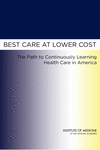The Path to Continuously Learning
Health Care in America
Description:
 America's health care system has become too complex and costly to continue business as usual. Best Care at Lower Cost
explains that inefficiencies, an overwhelming amount of data, and other
economic and quality barriers hinder progress in improving health and
threaten the nation's economic stability and global competitiveness.
According to this report, the knowledge and tools exist to put the
health system on the right course to achieve continuous improvement and
better quality care at a lower cost.
America's health care system has become too complex and costly to continue business as usual. Best Care at Lower Cost
explains that inefficiencies, an overwhelming amount of data, and other
economic and quality barriers hinder progress in improving health and
threaten the nation's economic stability and global competitiveness.
According to this report, the knowledge and tools exist to put the
health system on the right course to achieve continuous improvement and
better quality care at a lower cost. The costs of the system's current inefficiency underscore the urgent need for a systemwide transformation.
About 30 percent of health spending in 2009--
roughly $750 billion--was wasted on:
roughly $750 billion--was wasted on:
unnecessary services
excessive
administrative costs
fraud
and other problems.
Moreover,
inefficiencies cause needless suffering.
By one estimate, roughly 75,000
deaths might have been averted in 2005 if every state had delivered
care at the quality level of the best performing state. This report
states that the way health care providers currently train, practice, and
learn new information cannot keep pace with the flood of research
discoveries and technological advances.
About 75 million Americans have more than one chronic condition, requiring coordination among multiple specialists and therapies, which can increase the potential for miscommunication, misdiagnosis, potentially conflicting interventions, and dangerous drug interactions. Best Care at Lower Cost emphasizes that a better use of data is a critical element of a continuously improving health system, such as mobile technologies and electronic health records that offer significant potential to capture and share health data better. In order for this to occur, the National Coordinator for Health Information Technology, IT developers, and standard-setting organizations should ensure that these systems are robust and interoperable. Clinicians and care organizations should fully adopt these technologies, and patients should be encouraged to use tools, such as personal health information portals, to actively engage in their care.
This book is a call to action that will guide health care providers; administrators; caregivers; policy makers; health professionals; federal, state, and local government agencies; private and public health organizations; and educational institutions.
After Reading, If you still feel we don't need Health Care Reform, then read it again.
Please note, the Primary Frauders were the Hospitals, Drs., Nurses, and Big Pharma.
Report Medicare Health Care Fraud>> http://oig.hhs.gov/fraud/report-fraud/index.asp
Please note, the Primary Frauders were the Hospitals, Drs., Nurses, and Big Pharma.
Report Medicare Health Care Fraud>> http://oig.hhs.gov/fraud/report-fraud/index.asp
~~~~~~~~~~~~~~~
Not Enough??
by Mike Adams
Watch the Video
Not Enough??
"Why Doctors are more dangerous than guns"
Aug 3, 2012 – (NaturalNews) According to U.S. government statistics, you are 6200% more likely to be killed by your doctor than by a homicidal shooter.by Mike Adams
Watch the Video
May you find Strength in Your Higher Power,
Keeper of the web files for http://nfpcar.org



